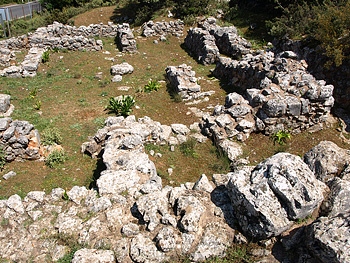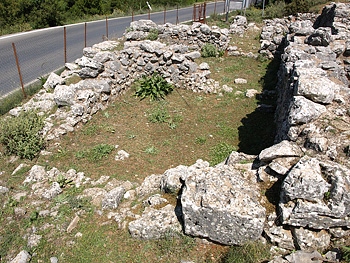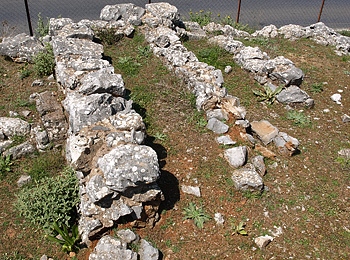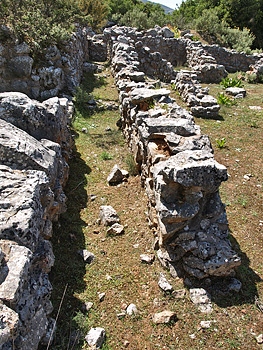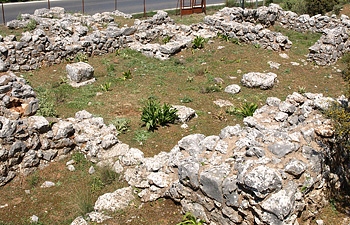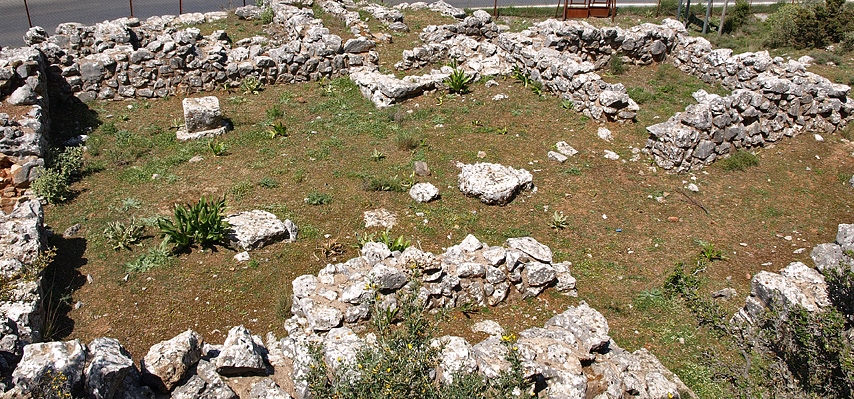
LM I villa
The Minoan villa of Sklavokambos was discovered in 1930 when the road to Anoyeia was being constructed. The villa lies just above a river, in a long narrow valley 22 kilometres south west of Heraklion and a few kilometres from Tylissos. Parts of the villa were sadly destroyed by the construction of the road.
The orientation of the building is almost exactly north-south. The facade of the building was on the north side and the entrance was on the east side (area 1 on the plan), with a courtyard probably in front of it. The entrance had two doors and the bases of the doorjambs, in soft rock are preserved. In fact many door jamb bases are preserved throughout the site in the more important rooms, sometimes with the threshold, also in soft rock. In the less important rooms the doorways are simple openings in the walls without using particular materials. One metre above the floor level of the entrance a stone hammer was found and a clay human foot. Here were also found the main find of the excavation, the 34 clay sealings. These were found in a heap in the adjacent room 2, Also found here was half of an almost cylindrical vessel. All these finds certainly came from the upper floor which it is thought contained a cult area and had fallen with the collapse of the building on its destruction in LM IB. These finds show that the occupants of the country house had contacts across Crete. One seal impression has also been found as far away as Zakros, Gournia and, in the opposite direction, Ayia Triada.
The villa was destroyed by fire so fierce that the stones were calcified and sometimes fused into an indissoluble mass that at first made the excavator wonder if they were dealing with a lime kiln.
The right hand side of rooms 2-3 are so badly destroyed that the position of the entrance to these rooms isn't clear. The entrance leads to a large room (4) (6.70 x 3.30 metres), that was the main room of the villa. Unfortunately this room was largely destroyed by the building of the road, especially the eastern part. Finds in the room included the clay head of a bull and a stone rhyton. Also found here were sherds from the finest vessel found in the excavation, a large jug.
The excavators concluded that there had been a polythyron in the south wall of room 4 and in the same position on the floor above. On the ground floor this would have opened onto an east-west corridor (5). At the end of corridor 5 on the right there was a staircase (6 and 7) which would have led to an upper floor. The excavator claims that the area under the upper flight of stairs (7) had been made into a toilet. A hole at the far end of this space was connected to an underground drain leading perhaps to the river, north of the villa. This drain, with a square section, was constructed on its two sides and above from large slabs of unworked stone. Most of the drain had been destroyed by the building of the road. Inside it, however, a bronze dagger was found. Inside the toilet (7), two clay spherical objects were found. The excavator believed that they were plugs that were placed over the hole leading to the drain to exclude the smell from the sewer below.
Between the large room 4 and the staircase was a small room 8 which was entered from beneath the staircase. The floor of this room was covered in a thin layer of black ash. Many handless cups were found here, almost all of them turned upside down. Also found in the room was a small clay brasier also turned upside down. This room is thought to have been a small shrine in the villa.
Left of the corridor was a single entrance to rooms 9 and 10, partially separated by a dividing wall. Nothing was found in these rooms making it difficult to allocate a use to them.
Another group of rooms 11-13 is located at the far west end of the corridor. Rooms 11 and 12 were storerooms (see photo above) and room 13 was a veranda. Room 11 contained three pithoi, which it seems were placed there later, when room 12 was already full. The bottoms of the three pithoi were placed in earth at different heights. This is the lowest of all the rooms in the house so that the walls are preserved to a greater height than elsewhere in the building. Today the south wall is preserved to a height of 2.40 metres. The veranda is reached from an entrance in room 11 with some difficulty as there is a difference in floor level of nearly half a metre. It seems that originally room 11 was not intended to be a storeroom but when room 12 proved inadequate the floor level of room 11 was deepened and the pithoi were gradually added to this room as well. At the lowest levels charcoal and darkened earth was found to contain pieces of bronze plates and some nails.
The main storeroom 12 contained eleven pithoi round its walls. They were found upright in their places but due to the pressure of the earth and the fire in the villa each had been crushed into many pieces.
It was not possible to get into the south-west part of the building from any of the north rooms. One had to leave the building and follow a path round to the south side where there was a separate entrance more or less half way along the south side of the building. The large, irregularly-shaped, limestone threshold is still preserved. This would appear to be the main entrance to this part of the villa, although a secondary entrance exists at the southeast corner of the building. The remains of a paved pathway leads along the south wall outside the building between the main entrance and the secondary entrance.
Both entrances open onto the long, narrow south corridor (14). It seems that this was also used as a storeroom as crushed pieces of a fine pithos and two neolithic axes were found here.
Across the corrdior from the main entrance is room 15. According to the excavator this was the spacious central courtyard. It is a slightly unusual shape as the southern part of room 9 protrudes into the rectangular space of the courtyard. In the centre of the building three large, roughly-worked pillars were uncovered. The fourth pillar would have occupied the southwest corner of room 9. The measurements of the pillars were irregular and the building of them so skimp that the excavator felt certain that they would have been covered with plaster. Some of this, combining plaster with small stones and pebbles from the river, was found in the area. Only the northeast pillar remains to a height of 1.40 metres. For the other pillars only the bottom stone remains, in poor condition.
Due to the protruding west wall of room 9, the north part of the courtyard takes the form of a narrow space, separated off from the rest of the courtyard. Here the natural rock protrudes into the courtyard and has been left untouched, full of cracks. It was covered in a thick layer of black soil caused by the decomposition of organic matter, but small pieces of charcoal and animal bones were also discovered. The black soil, full of shards from vessels was also found inside the cracks in the rocks. All this suggested to the excavator the presence of a hearth. Other finds in the courtyard included more pottery sherds and a third neolithic axe.
Other archaeologists have subsequently referred to this area as a hall, not a courtyard.
On the east side of the courtyard there is room 17, inside which a clay pyxis was found and another area 16, which is completely open to the courtyard. On the west side of the courtyard lie rooms 18 to the north and 19 to the south, which can be entered either from the courtyard or from the long corridor 14 at its west end. The excavator considered these rooms to be the kitchen area. They contained small pithoi which are known from other excavations to have contained wheat, pulses and figs. A pestle, millstone and a grindstone were found in room 19. The floor of room 19, close to the rising ground of the mountain to the south, was on two levels. Attached to the southwest corner of the villa was an outbuilding with no visible means of access at ground level (20).
The building is not as sophisticated as those at Tylissos, just down the road. It did not have frescoes or gypsum finishing, but the country house was solidly built if somewhat cruder than those at Tylissos.
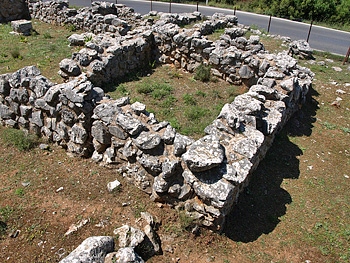
Room 17
|
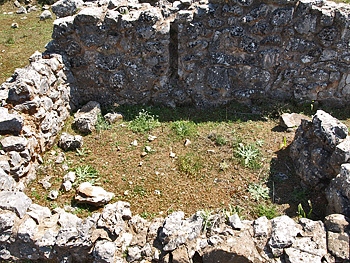
Room 9, the room which protrudes into room 15
|
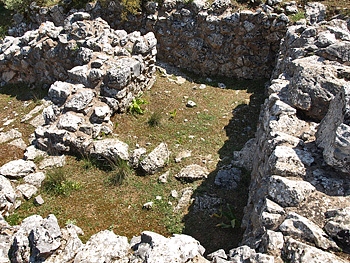
Room 19a and 19b
|
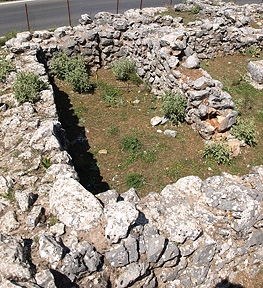
Room 18
|


